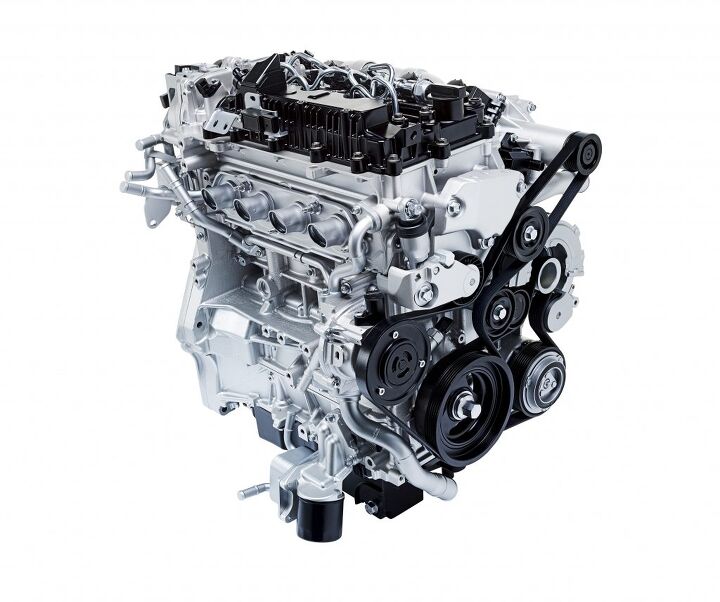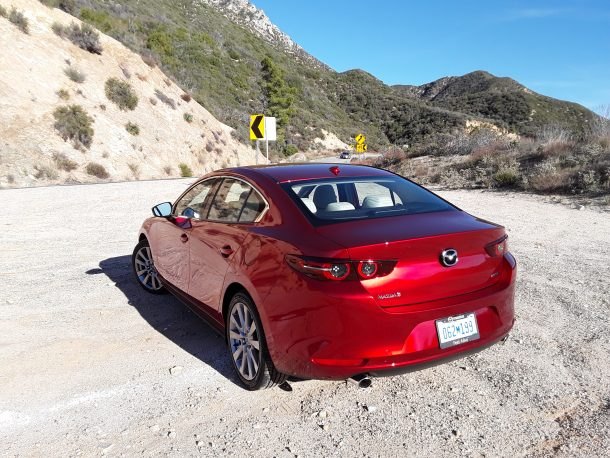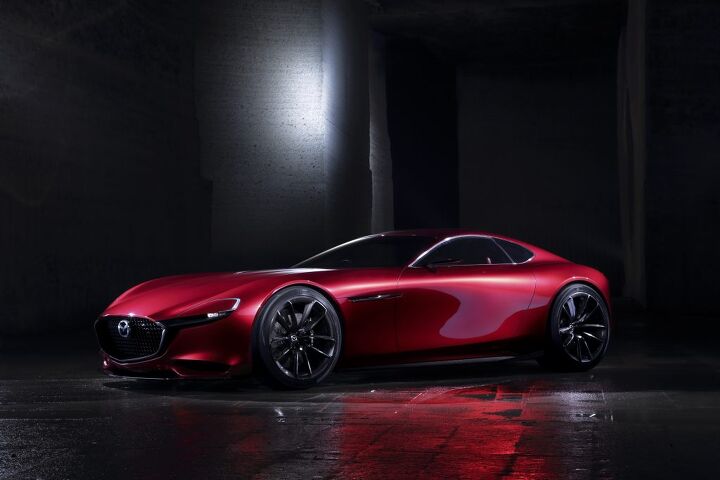#skyactiv-x
Mazda's U.S. Skyactiv-X Arrival Definitely Delayed
While other manufacturers are downsizing engines and sticking turbos anywhere they’ll fit, Mazda has attempted to maintain a home for naturally aspirated motors — engines it believes should be sized appropriately for their intended application. On paper, this appears to be giving the competition an edge. Yet Mazda remains committed to offering the right tool for the job, introducing naturally aspirated Skyactiv engines with unusually high compression ratios. The latest, Skyactiv-X, combines spark-controlled gasoline combustion and compression-ignition diesel tech with a 24-volt mild-hybrid system.
The system delivers 178 horsepower and 164 lb-ft of torque in 2.0-liter guise, plus MPG improvements of up to 20 percent vs the old Skyactiv-G. But there’s a problem. With Mazda attempting to go upmarket, an economy-focused powertrain has to deliver in whatever region it’s sold, and introductory Skyactiv-X units are now viewed as too small for the United States. The result? The technology’s delayed arrival in North America, despite its deployment via the new 2.0 liter found in the 2020 Mazda 3 and CX-30 sold in Japan and Europe.
Mazda Launches Skyactiv-X Engine in Europe, Fuel Economy and Power Revealed
Mazda fans on this side of the Atlantic will have to wait patiently for their turn, as the innovative Skyactiv-X-powered Mazda 3 now available in Europe won’t show up here for some time.
On Wednesday, the company announced that continental buyers can begin placing orders for models equipped with a Spark Plug Controlled Compression Ignition (SPCCI) 2.0-liter four-cylinder, tossing out fuel economy and power figures along the way.
Let's Talk About Six: Mazda Confirms New Inline Engine in Development
Much of the news surrounding Mazda this past year has concerned powerplants: a new turbocharged 2.5-liter four-banger for the CX-5 crossover and 6 sedan, a sort-of sparkless Skyactiv-X mill that still doesn’t have a North American arrival date, a lackluster diesel that took its sweet time getting here, and the brand’s continued lack of electric offerings.
The engine news continues. Buried within this week’s fiscal year earnings report is a hint of two new engines to come — inline-six engines. For a brand eager to position itself as premium, the development of a mill widely regarded as the classiest engine type reflects well on it.
On ICE: Mazda's Skyactiv-X Wonder Engine Isn't in a Hurry to Get Stateside
Much-touted engines seem to take a while to arrive in North America, at least when it comes to Mazda. To the brand’s credit, those engines, at least in the case of the Skyactiv-D diesel, do eventually make it to these shores — though many wonder whether Mazda should have even bothered.
The Skyactiv-X is a different beast than its diesel counterpart. With this engine, Mazda promises increased power and greatly increased efficiency, all thanks to the engine’s novel combination of gasoline and diesel combustion elements. Journalists were offered a test drive over a year ago, but when the next-generation Mazda 3 appeared earlier this year, the 2.0-liter Skyactiv-X was nowhere to be seen. What gives?
Skyactiv-X Engine Debuts Inside 2019 Mazda 3 This Month
Mazda is bringing its new Skyactiv-X engine, hyped as a major leap forward in internal combustion engine technology, to the Los Angeles Auto Show and the end of the month. Wedged inside the new Mazda 3 sedan and hatchback, the powerplant uses “Spark Controlled Compression Ignition,” which is said to combine the efficiency of a diesel unit with the performance of a gasoline mill. The manufacturer claims fuel economy improvements of more than 30 percent over a standard gasoline engine of the same displacement.
Assuming Mazda meets that mark, it’s a petty impressive feat. The 2.0-liter four-cylinder will debut along with the 3’s new platform in L.A. at the end of the month.
Mazda Skyactiv-X Prototype First Drive - Is the Future Highly Compressed? [UPDATE]
In an era where just about every automaker is talking about electrification of its powertrains to some extent or another, Mazda is taking a different tack — remaining heavily focused on the good ol’ internal combustion engine.
This doesn’t mean electrification isn’t part of the company’s future powertrain strategy – it is – but in the nearer term, the company is working on ways to increase power while boosting fuel economy in its small gas-powered engines.
(Before we get to that, yes, the company’s long-promised diesel is still coming to America, though there’s still no official date.)
In order to show off its new tech, Mazda invited journalists to its research and development HQ in Irvine, California to drive prototypes outfitted with the Skyactiv-X engine.
More Internal Combustion Abandonment: Mazda Plans Fully Electric Fleet By 'Early 2030s'
Mazda recently announced the testing of its Skyactiv-X compression ignition engine, which promises to burn gasoline with diesel-like efficiency. If it hits its projected launch date of 2019, it will become the first mass-produced motor of its type and is likely to be showered with praise from environmentalists and enthusiasts alike.
However, as we progress deeper into the millennium, it’s becoming evident that more and more automakers are willing to embrace electricity as the next solution to efficiency. That makes Mazda a bit of an oddity, maybe even a dinosaur, and we were wondering when the company would give in to electrification. Especially since it has already partnered with Toyota to tighten its grasp on the technology.
This Is What Mazda EPA MPG Results Will Look Like With Skyactiv-X HCCI Engines (Asterisk, Fine Print, Subject To Change)
Mazda announced on August 8th what had long been rumored. The small Japanese automaker has successfully overcome the remaining issues which held at bay mass production of gasoline compression ignition.
Essentially, Mazda’s Skyactiv-X engines, due first in the next-generation 2019 Mazda 3, is intended to bring diesel-like ignition to small, supercharged four-cylinder engines, along with diesel-like fuel economy. However, the gas-fired Skyactiv-X engines will be wildly cleaner than diesel powerplants. Mazda has said in the past that these HCCI engines will likely limit the need for continuously variable transmissions. We also learned, with Mazda’s latest pronouncement, that the company’s Skyactiv-X engines will be significantly torquier than their Skyactiv-G predecessors.
If Mazda can live up to its pronouncements — the company says the engines are “still under development and figures are subject to change” — it’ll be a win for both the environment and driving enthusiasts. And because Mazda also claims a 20-30-percent improvement in fuel efficiency, it’ll be a win for your bank account, as well.
We wanted to see exactly where Mazda’s alleged fuel savings will put Mazda’s current products on the EPA’s miles per gallon scale, so here are the results of some quick math.
Mazda Going (Mostly) Sparkless With Skyactiv-X Gasoline Engines, Starting in 2019
There’ll still be spark ignition available, but Mazda doesn’t expect you’ll get a whole lot of use out of it. With its just-revealed Skyactiv-X engine technology, the gasoline-loving automaker has added a new way of making power to the automotive realm: the compression ignition gas engine.
It’s something we’ve known about for a while, but today saw its confirmation. Mazda’s Skyactiv-X engine, bound for its vehicle lineup in 2019, adopts technology forever associated with diesel engines and combines it with a lighter, much cleaner fuel. Apparently, going green needn’t require batteries and AC motors.








![Mazda Skyactiv-X Prototype First Drive - Is the Future Highly Compressed? [UPDATE]](https://cdn-fastly.thetruthaboutcars.com/media/2022/07/19/9197970/mazda-skyactiv-x-prototype-first-drive-is-the-future-highly-compressed-update.jpg?size=720x845&nocrop=1)















Recent Comments